The Best Chest Exercises For All Levels Of Gym-Goer
Build a bigger chest with this range of exercises suitable for all levels
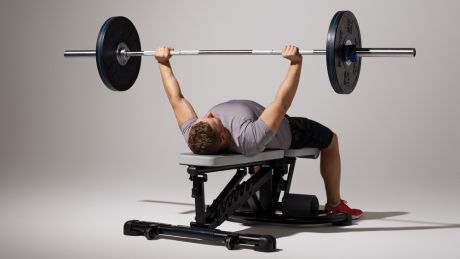
If you spend a lot of time in the weights room, or are about to commence a rigorous gym routine, there’s a good chance you want to bulk up your chest. Frankly, even if you have no intention of ever stepping into a gym, the chances are you wouldn’t say no to bigger pecs. Unfortunately there’s no magic shortcut to take – it’s only going to happen if you work at it.
“Building a bigger chest certainly doesn’t happen overnight, but doing the right exercises which target your pectoral muscles from every angle using appropriate rep ranges will ensure you get the results from the graft,” says Robert Stevenson, Optimum Nutrition Gold Standard PT of the year.
“To develop your chest, ensure that you include chest exercises in your workouts a minimum of two days a week. If you’re an experienced lifter, incorporate maximal (one to three reps), heavy (four to eight reps), moderate (eight to 12 reps) and lighter (12-plus reps) sets. If you’re new to the gym, stick to lighter weights and higher rep ranges until you refine your technique.
“It’s extremely important to work your chest from all angles and not only focus on the the biggest muscles in your chest – the pectoralis major – but also the smaller ones such as the pectoralis minor and clavicular pectoralis.”
To help you on your way to a bigger chest, we asked Stevenson and Keith McNiven, founder of personal training company Right Path Fitness, to recommend their favourite chest exercises for beginner, intermediate and advanced gym-goers, and we’ve thrown in a couple of our favourites as well.
Beginner Chest Exercises
Hands-elevated press-up
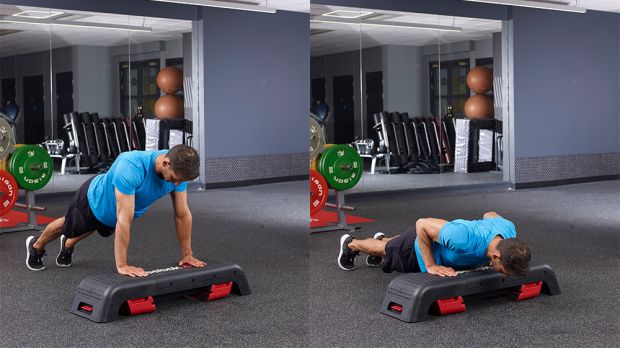
A great place to start for complete beginners – pop your hands on an elevated surface and do a press-up.
“This exercise allows you to very easily adapt the difficulty of a press-up. You could perform it against an elevated surface such as a bench, box or on a bar in a squat rack,” says Stevenson.
Get the Coach Newsletter
Sign up for workout ideas, training advice, reviews of the latest gear and more.
“It’s one of the most common exercises I use with clients starting out who aren’t quite ready for a press-up on the floor.”
Incline dumbbell press
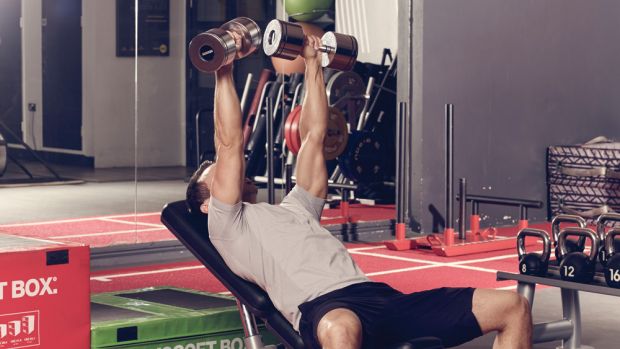
Set up a bench so it’s at a 45° angle. Lie on the bench holding a dumbbell in each hand by your shoulders with your elbows bent at 90°. Press the dumbbells up until your arms are straight. Lower under control.
“Starting on the flat bench can be quite daunting and awkward for beginners in the gym. Starting on an incline makes the transition getting the dumbbells up slightly easier,” says Stevenson.
Resistance band flye
Hook two resistance bands to a fixed post behind you. Hold the other ends of the bands out to your sides with your arms straight. Slowly bring your arms around until they meet in front of your chest, keeping your arms straight throughout, then slowly take them back to the starting position.
“This is a safe and effective way of learning the difference between a press and a flye movement for beginners,” says Stevenson.
“Using the bands creates maximum tension at the point in the exercise where your hands meet in the middle. It also means there’s less risk of injury when you’re at the stretch point of the exercise.
“This can also be used as a finisher to get an unreal chest burn at the end of a workout. Try 60 seconds of high-tempo reps and you’ll see what I mean!”
Press-up

You’ll find several press-up variations in this list, which speaks to how great a chest exercise it is. It’s worth making sure you’ve mastered it before moving on to intermediate exercises, but if it proves too tough then check out the hands-elevated press-up above.
Start in a high plank position, supporting yourself on your hands and your toes with your body forming a straight line from your neck to your ankles. Bend your elbows to lower your chest until it’s just above the floor, then press back up, keeping your elbows close to your sides.
Shoulder tap
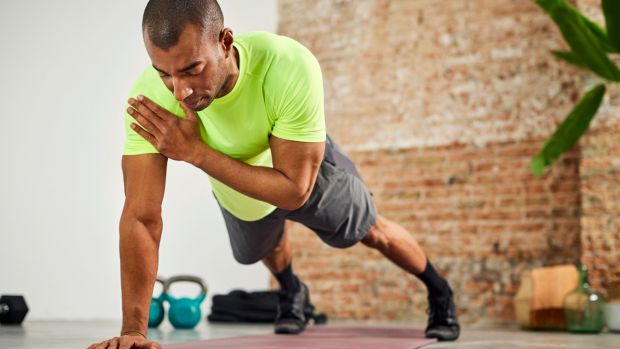
This plank variation is great for your core and shoulder strength as well as your chest. Start in a high plank position, with your hands positioned under your shoulders, your body forming a straight line from your neck to your ankles. Lift your left hand to tap your right shoulder, return to the high plank, then tap your left shoulder with your right hand. Continue alternating, making sure you keep your hips still and your core engaged throughout.
Intermediate Chest Exercises
TRX press-up to flye
Holding the straps with your hands shoulder-width apart and palms facing down, lean into a pair of TRX ropes with straight arms. Lower yourself until your thumbs are level with your armpits, then press up. Turn your wrists so your palms are facing in, keeping your elbows slightly bent, and move your hands out to the sides, so your chest drops down and is between the handles. Bring your hands back together to push your chest back up to the start position.
“As with the hands-elevated press-up, the difficulty of this variation can be altered drastically by simply moving your foot position,” says Stevenson. “The further your feet are from the TRX ropes, the harder it will be.”
“What makes this exercise challenging is the balance and stability aspect. Alternating between a press-up and a flye movement takes a bit of co-ordinating, but once you suss it out you’ll feel the added effect of combining these two exercises into one.”
Barbell bench press
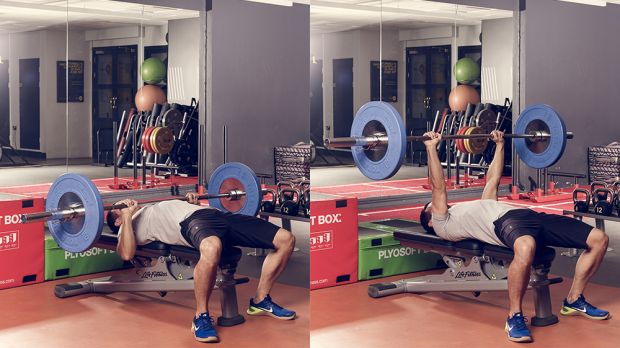
A classic chest exercise, and that’s meant only as a compliment. Lie on a bench and grasp a barbell with your hands slightly wider than shoulder-width apart. Bring the bar down to your chest, then push it back up.
“This is and always will be the daddy of chest exercises,” says Stevenson. “A mixture of decline, flat and incline bench presses will ensure you hit your chest from top to bottom.”
Cable cross-over
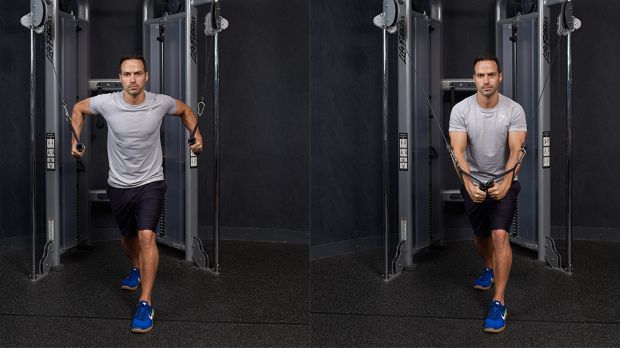
Stand in the centre of the cable machine with both ends of the pulleys at the highest level. Bend forwards slightly at the waist and hold the handles with your elbows bent a little. Pull the hands down and across your body, then slowly take them back to the starting position, keeping the bend in your elbows throughout the movement.
“This is easily my second favourite exercise after a bench press,” says Stevenson. “The cable cross-over enables you to work from low to high, across the middle, and high to low on the pulley machine, and ensure you get the chest DOMS that everyone craves. Superset this one with any chest press for maximal gains and a horrendous burn.”
Resistance band cross-over
“The cross-over exercise on the cable machine is an excellent way to work your chest, but you can also do the move using resistance bands,” says McNiven. “A benefit of using resistance bands is that then you can do the move at home or outdoors.
“Wrap the resistance band behind a stable surface like a post, and face away from the post holding the ends of the band in each hand. Bring your arms out to the sides, opening up your chest, and then bring the ends of the resistance bands together in front of your chest in a controlled movement.”
Gym ball press-up
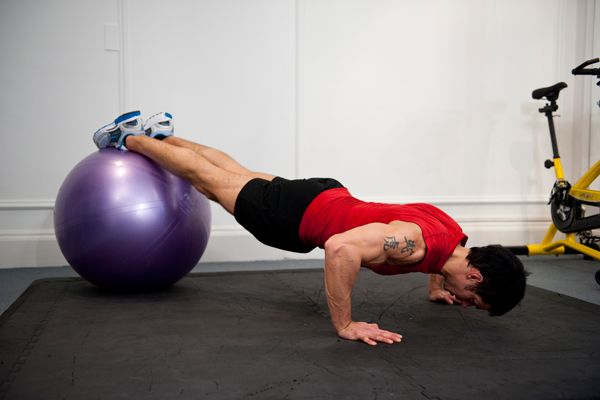
“The press-up is one of the best exercises for the chest and if you want to really challenge yourself, introduce a gym ball,” says McNiven. “Stand with the ball in front of you, then place your abs on the ball and your hands on the floor. Walk your hands forwards and roll your body along until the ball is firmly under your toes and your arms are taking your weight. Keep your arms just wider than shoulder-width apart. As you inhale, bend your elbows to lower your body under control, and then as you exhale extend your arms and push back up.”
Wide-arm press-up
Moving your hands further apart for your press-ups increases the focus on your chest muscles. However, it’s important not to place your hands too far apart and ruin the quality of your press-ups as a result – make sure you can move slowly and with control throughout the move, and if you can’t, bring your hands closer together until you can.
Floor press
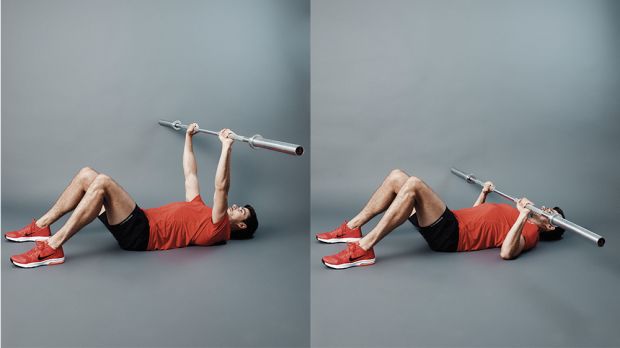
A great move to do when the bench is busy, the floor press allows you to work your chest in a similar way to the bench press – but there are some key differences between the exercises. Lying on the floor and pressing the bar above you has a smaller range of movement than the standard bench press, so it puts less stress on your shoulders; it also means you can’t involve your legs in the press, so more work is done by your chest. Another difference is that as your arms touch the ground with each rep you lose the tension in the muscles, so you have to get going again from scratch with each lift, making the start of each press noticeably tougher.
Lie on the floor on your back with your legs either extended or bent at the knee with your feet flat on the floor. Hold a barbell with hands shoulder-width apart above your chest. Lower the bar to your chest slowly, allow your shoulders to meet the ground, then push the bar back up explosively.
Dumbbell flyes
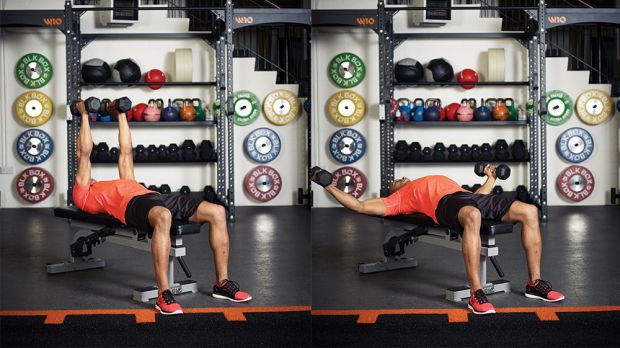
To hit a wider range of chest fibres than the bench press, set yourself up with two dumbbells and a flat bench. Lie on your back holding the dumbbells above your chest with arms extended towards the ceiling. Keeping a slight bend in your elbows and your back flat against the bench, lower the dumbbells out to the sides as far as is comfortable. Pause briefly, then bring the dumbbells back together above your chest. Aim for three sets of eight reps and use a weight that makes the final few reps tough to get through.
Kettlebell incline flye
Introducing some incline to your chest workouts is a smart move because it enables you to hit the muscles from different angles. We recommend using kettlebells for this particular flye because it keeps the weight on the outside of your wrists, which means it’s easier to maintain the same bend in your elbows throughout the move. Set up a bench at a 15° angle and lie back, holding a kettlebell in each hand above your shoulders with your palms facing. Lower the weights out to the sides, keeping a slight bend in both elbows, until you feel the stretch across your chest. Then slowly lift the bells back to the start by squeezing your chest.
Landmine press
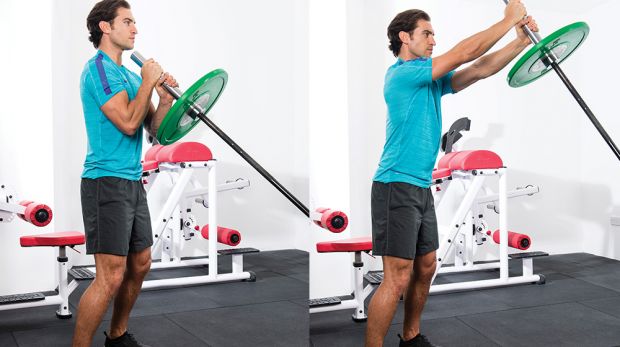
The landmine press works your chest, arms and shoulders while putting less pressure on the shoulder joints than a typical press, thanks to the curving path of the lift. Secure one end of a barbell in a corner (wrap a towel around it to make sure you don’t scratch any walls) and load weight plates on the other end. Stand holding the weighted end in both hands in front of your chest. Press it up until your arms are extended, then bring it back down. You can also do the move holding the bar in one hand, or for more stability, do it while kneeling instead of standing.
Divebomber press-up
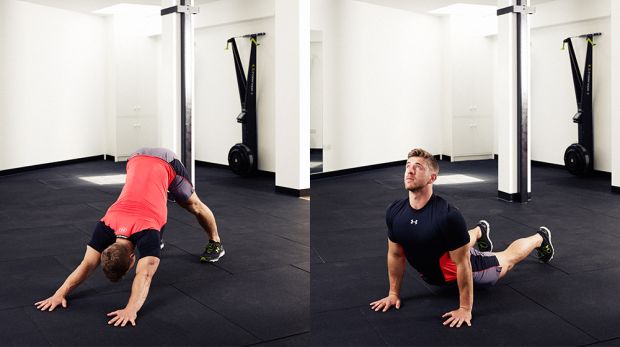
Another great press-up variation, the divebomber also works your hamstrings and stretches your lower back while still hitting the chest hard. The starting position differs from the standard move in that you pike your hips upwards. Then lower, moving your head forwards as you go to flatten your body until your hips and legs are hovering just above the floor. Then push forwards and raise your head and chest. Reverse the movement to return to the starting position.
See related
- The Ultimate Chest Workout: Build A Big Chest In Just 28 Days
- 20-Minute Chest Workout
- The Only Home Chest Workout You’re Ever Going To Need
- The Best Chest Exercises For Women
Advanced Chest Exercises
Bottom to top press-up
“You’ll need a squat rack or Smith machine for this one as well as a set of parallettes [tall handles],” says Stevenson.
“Start with the bar at the bottom of the rack, hold onto the parallettes and place your feet on the bar so your body is straight like it would be in a plank. Perform ten to 15 press-ups, ensuring your chest gets well below parallel on the parallettes.
“Then put the bar up to the next peg on the Smith machine or holes in the rack and do the same again. Repeat this until you’re at the top of the rack or your chest and shoulders can’t go any longer. This is the ultimate decline press-up progression and an impressive exercise in any gym.”
Single dumbbell press
“Not to be confused with a single-arm dumbbell press, this is a press using both arms but only one dumbbell,” says Stevenson.
“Imagine trying to squeeze a dumbbell from both ends so your force is towards the middle from either end. As soon as you apply the inward force, you’ll feel the muscle fibres in your chest starting to fire. Keep the constant pressure on as you press the dumbbell up and down. This exercise really targets the mid chest.”
Weighted dip
“Dips are simple, yet highly effective,” says Stevenson.
“Concentrate on leaning forward while lowering yourself on the dipping bars. Keep a reasonably wide grip if possible to maximally load the chest. For low-rep sets, wear a dipping belt or hold a dumbbell between your legs.”
Guillotine press
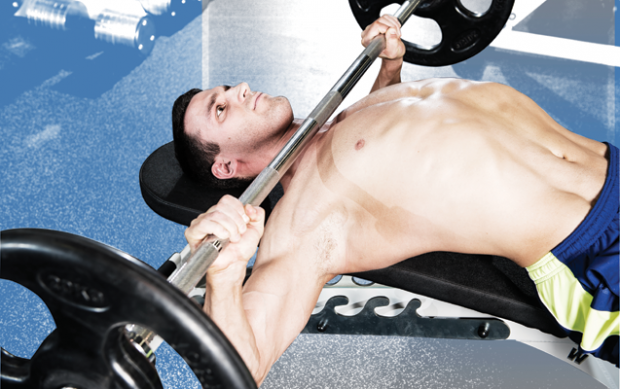
This charmingly-named exercise is definitely one for advanced gym-goers who have a trusted spotter, simply because if you get it wrong a barbell is going to apply an unwelcome amount of pressure to your throat. The lift is the same as the standard bench press, but instead of taking the bar down to your chest with each rep, you lower it towards your throat. This increases the range of motion of the move, because you can lower the bar further when aiming for the neck rather than the chest, and will force those pecs to grow big and strong as a result.
Clap press-up
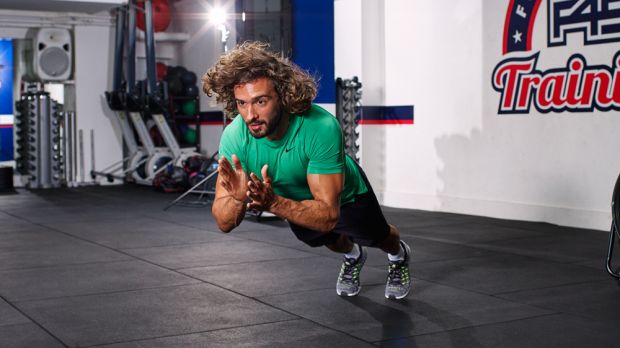
The clap press-up is a plyometrics powerhouse move that recruits the fast-twitch muscle fibres, stimulating growth in areas other exercises can’t. From the top press-up position, lower until your chest is almost touching the ground, then explode up with a push that’s powerful enough to give you time to clap your hands and return your palms to the floor.

Nick Harris-Fry is a journalist who has been covering health and fitness since 2015. Nick is an avid runner, covering 70-110km a week, which gives him ample opportunity to test a wide range of running shoes and running gear. He is also the chief tester for fitness trackers and running watches, treadmills and exercise bikes, and workout headphones.









